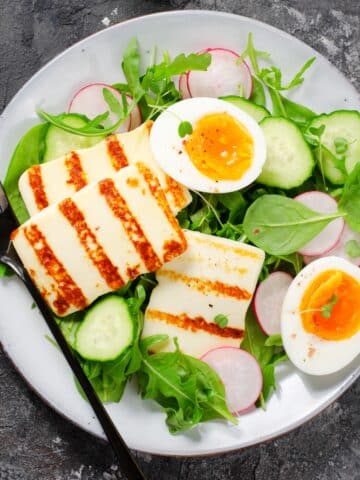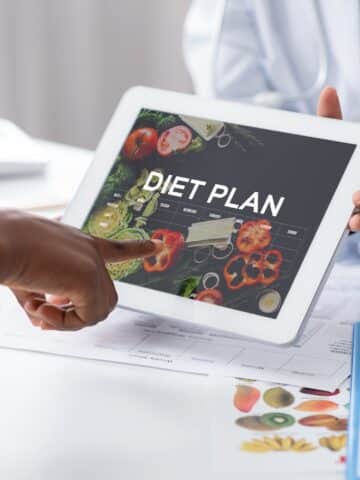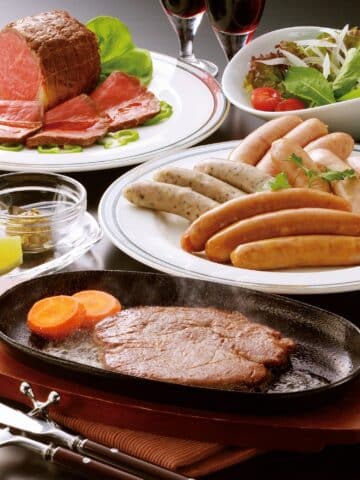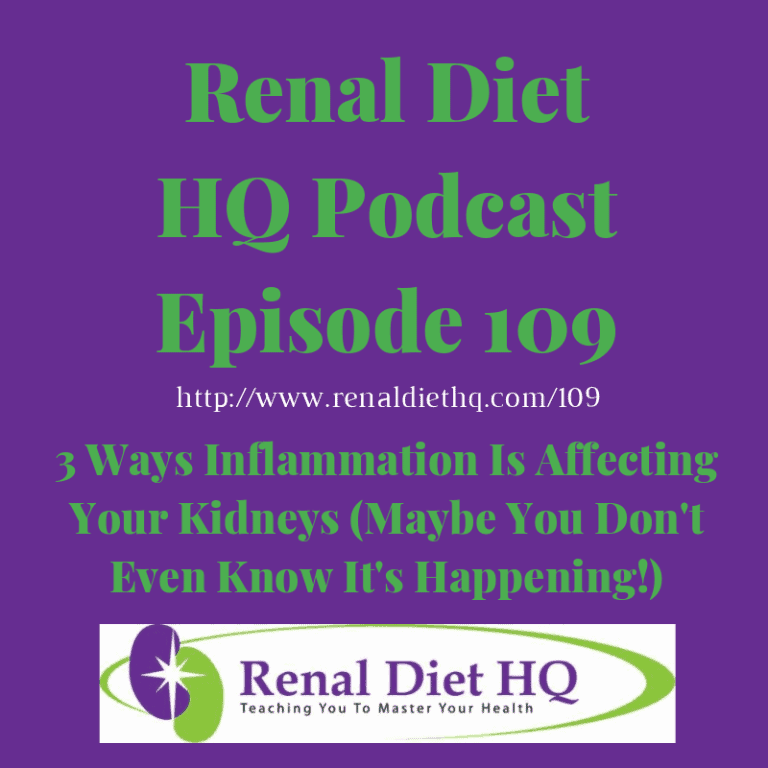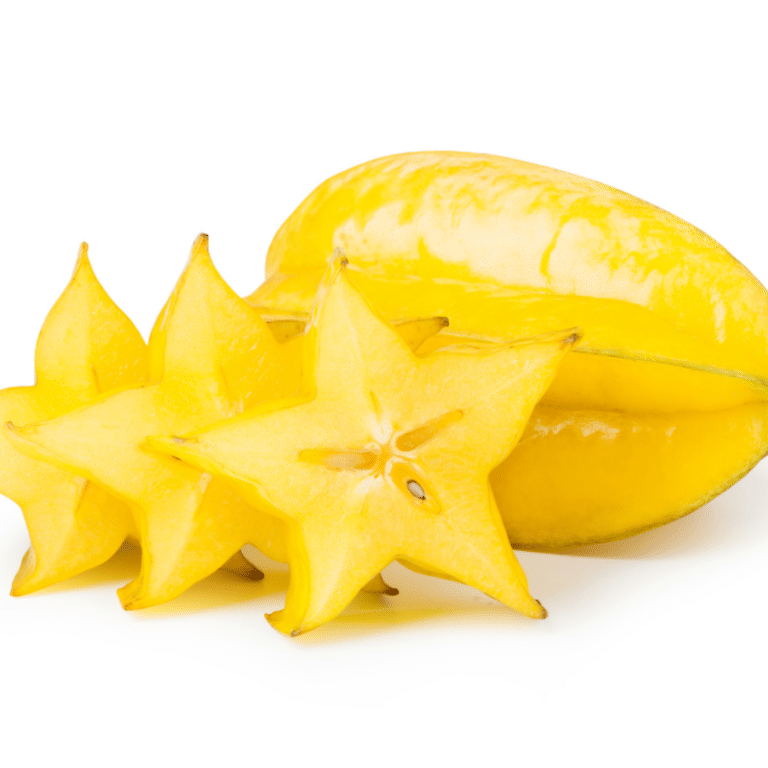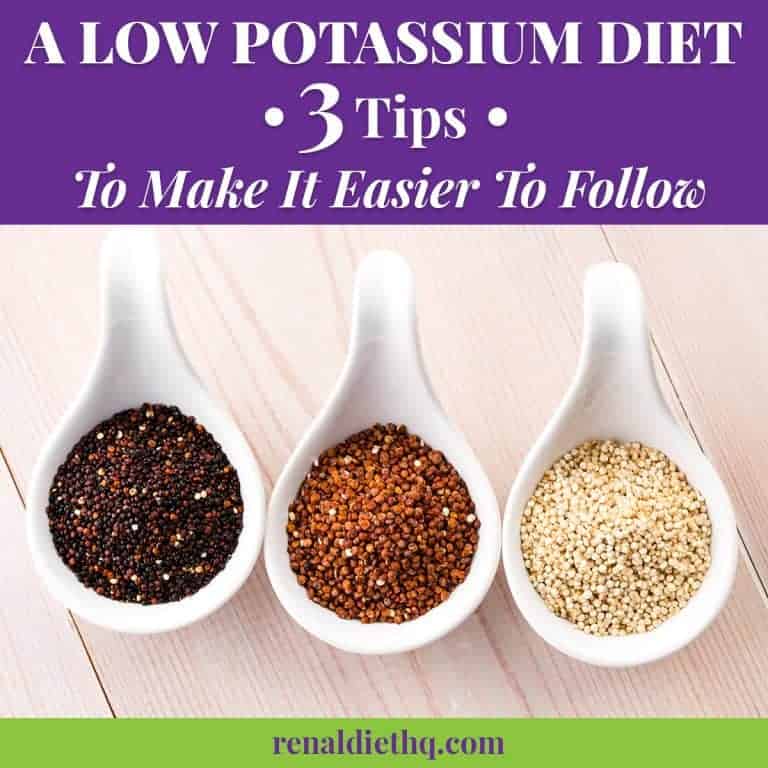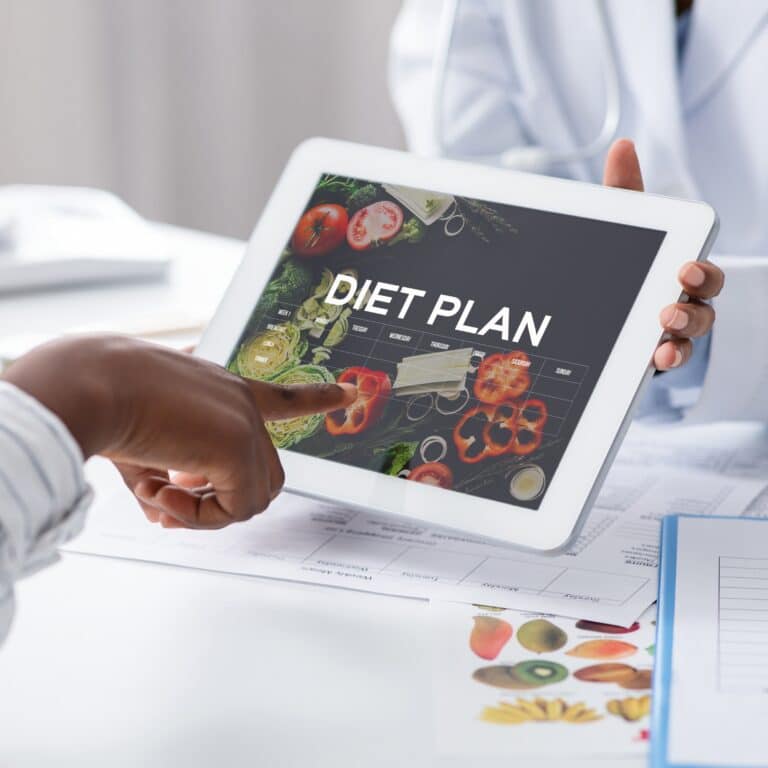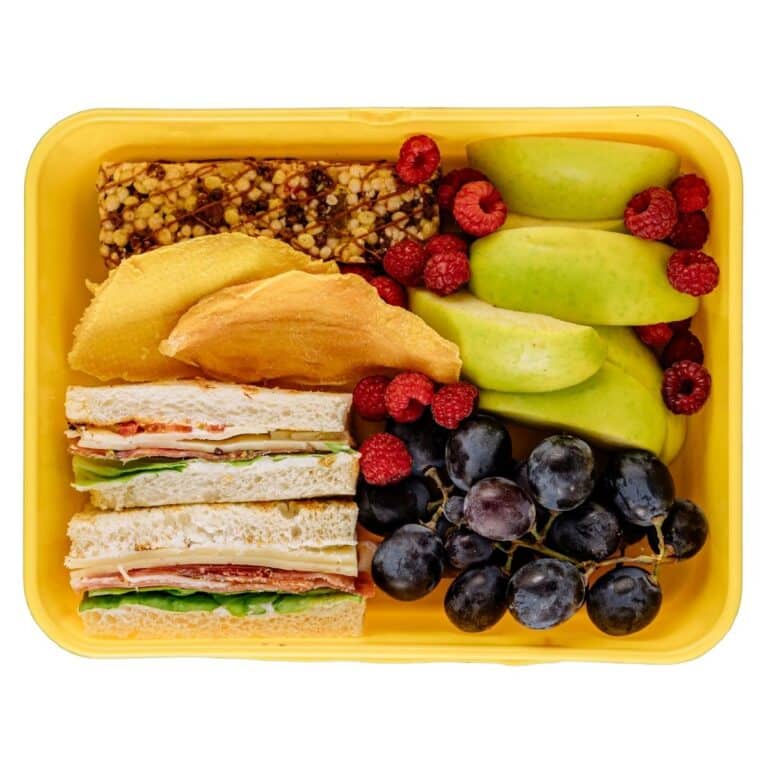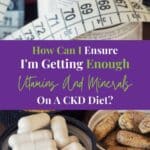Portion Control For CKD Patients: A Dietitian's Guide
Are you a dietitian looking to learn more about portion control for chronic kidney disease (CKD) patients? You've come to the right place.
In this article, we'll explore the CKD Diet plan, discuss how portion control can help manage it, and provide practical tips that you can use in your practice.
We'll also cover dietary approaches specific to CKD patients, so you can better serve them and their nutritional needs.
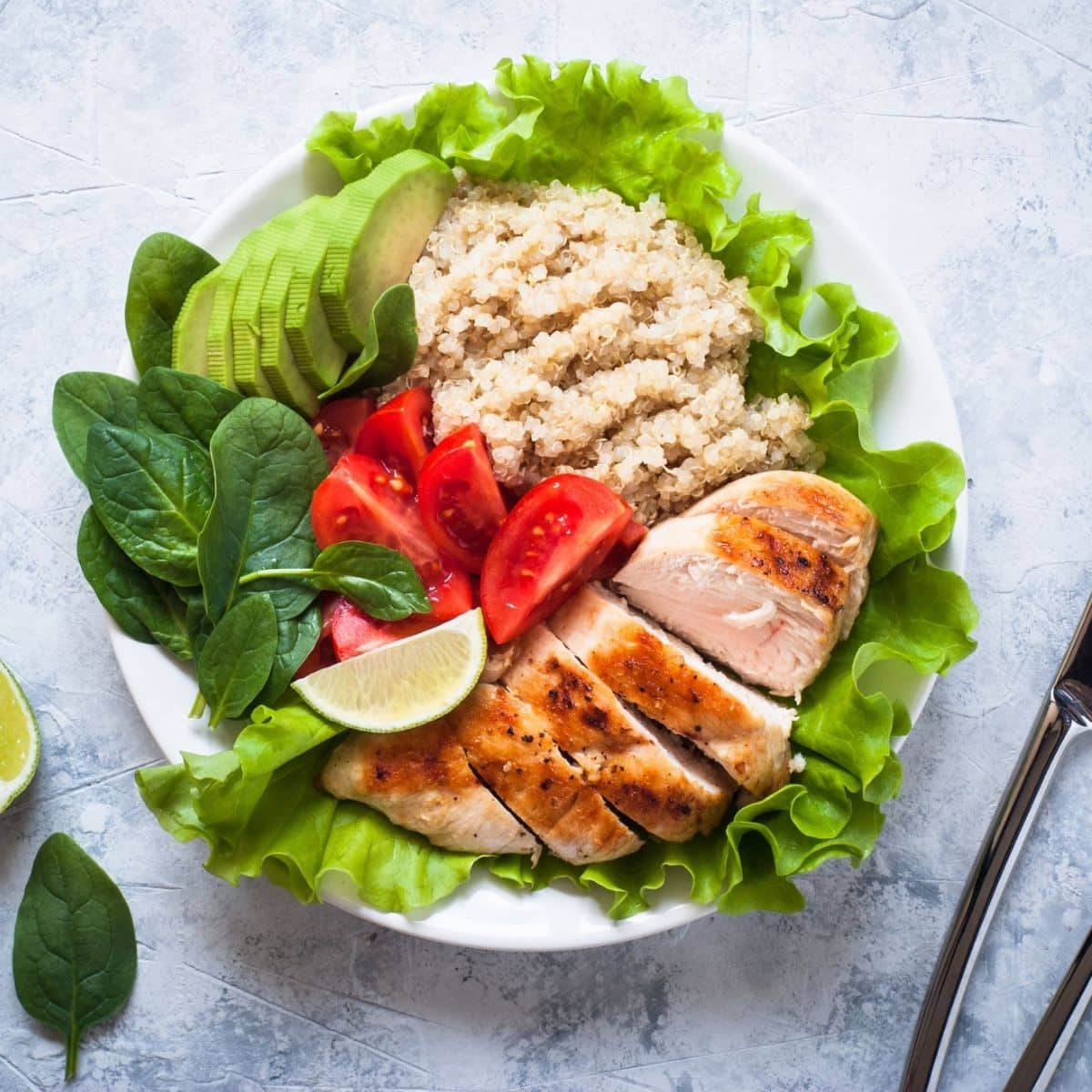
With our help, you'll be able to provide high-quality care while helping your clients make lifestyle changes that will benefit their health in the long run.
Jump to:
What is Chronic Kidney Disease?
Chronic Kidney Disease (CKD) is a serious condition that affects millions of people in the US. Diet and portion control can play an important role in managing CKD and improving overall health outcomes.
Controlling portions with a balanced diet tailored to individual needs may have many benefits, including reducing symptoms, improving quality of life, and reducing the risk of complications associated with CKD.
You may want to ask yourself questions like "can kidney disease cause heart problems?"
Prevalence In the US
It is probable that you, the reader, are among the over 37 million Americans currently living with Chronic CKD.
CKD is a serious medical condition that affects millions of Americans and can lead to life-threatening complications if left untreated.
The prevalence of CKD in the US has been increasing in recent years, with trends showing that it disproportionately affects African American adults. Other risk factors associated with CKD include diabetes, hypertension, obesity, and age.
For More Recipes and Ideas --->> Get Your Free Meals and Recipes That Are Perfect for Pre-Dialysis Diets, Pre-Dialysis with Diabetes, or Dialysis Diets.
How to Manage CKD
Management strategies for those living with CKD involve lifestyle modifications such as following a specialized diet plan, engaging in physical activity, stopping smoking, and limiting alcohol consumption.
Monitoring progress regularly through regular checkups and lab tests is also important for detecting compromised kidney function or signs of progression of the disease.
Lastly, community support from family members, friends, healthcare providers and other individuals living with CKD can help provide emotional comfort during this challenging time.
| Risk Factors | Lifestyle Changes To Manage CKD |
| Hypertension | Following a specialized renal diet |
| Diabetes | Exercise |
| Obesity | Stopping smoking |
| Old Age | Limiting alcohol intake |
What Is Portion Control?
Understanding how much food to eat can be tricky, but learning about portion control can help individuals with kidney disease make healthier decisions about their meals.
Portion control is a strategy for managing the amount of food you eat in a single sitting or over an extended period of time. This includes everything from grocery shopping and recognizing portion size myths to eating out and being mindful when eating.
When it comes to portion control for CKD patients, choosing the right type of foods with balanced nutrition is paramount.
It's important to select high-quality proteins such as lean beef or poultry, healthy fats such as olive oil, complex carbs such as quinoa, and plenty of fresh fruits and vegetables.
Here are three key components of portion control for CKD patients:
- Grocery Shopping – When grocery shopping, it's important to buy items that fit into the patient's overall dietary plan so they don't overeat later. Check out this Comprehensive Healthy Renal Diet Grocery List Guide.
- Recognizing Portion Size Myths – It's important to understand what constitutes a “normal” serving size instead of simply assuming larger portions are better.
- Eating Out & Mindful Eating – When dining out, it's essential to pay attention to how much is eaten. Avoid distractions like watching TV or surfing the internet while eating as this could lead to overeating without realizing it. Mindful eating can also help keep portions in check over time.
By following these strategies, CKD patients can become more mindful about their diet and make healthier decisions regarding food choices and portion sizes which will ultimately improve their health outcomes in the long run.
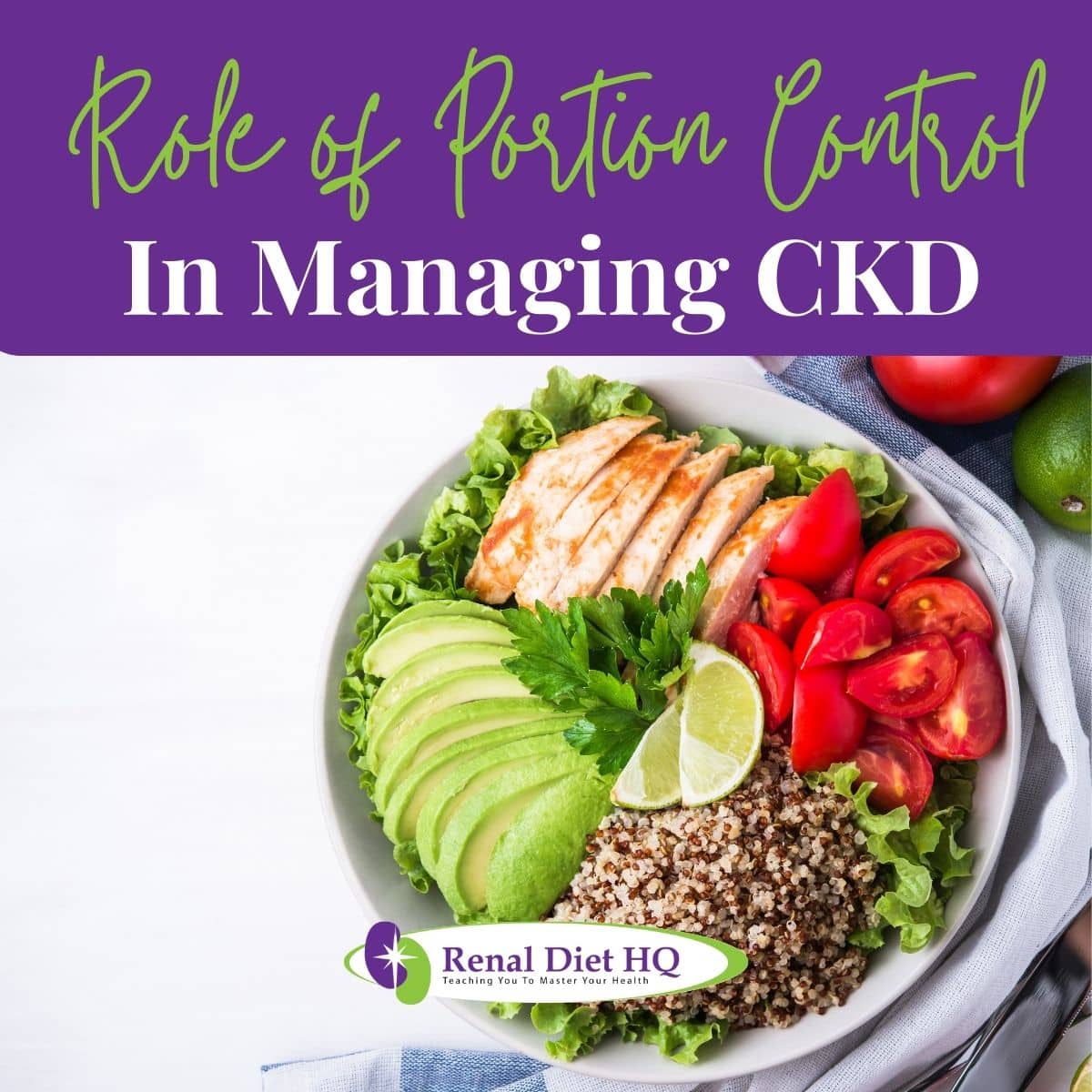
Role of Diet and Portion Control
For those living with CKD, diet and portion control are essential for managing the disease and promoting wellness. Kidney dietitians play an important role in helping these patients learn proper moderation strategies and portioning techniques to optimize their nutrient intake while ensuring that food selection is appropriate.
Portion control can be difficult for CKD patients due to decreased appetites, cravings, and lack of knowledge about what constitutes a healthy meal. Dietitians help individuals understand how to use measuring tools such as cups or spoons when preparing meals to ensure they are eating appropriate amounts of food.
Additionally, dietitians can provide education on how to make healthier food choices by reading labels and avoiding foods high in sodium or saturated fats that can worsen kidney health. With the right guidance from a qualified professional, CKD patients can successfully manage their kidney diets through portion control.
Understanding CKD and Diet
Understanding CKD and Diet can be a difficult topic to understand. You need to know the stages of CKD, how diet can slow ckd progression, and how it relates to diabetes.
A healthy diet is an important part of managing these conditions. It can help you take control of your health and prevent further damage from occurring.
CKD Stages
You're likely familiar with the different stages of CKD, and it's important to understand how each stage of kidney disease impacts your dietary needs. CKD is measured according to five stages, each indicating a decline in kidney function.
As kidney function decreases, so does the ability of the kidneys to remove waste from the body. Thus, as CKD progresses, dietitians may recommend changing portion sizes and food choices in order to promote better health outcomes for their clients.
| Stage | Description |
| 1 | Normal or near normal GFR (> 90 mL/min/1.73 m2) |
| 2 | Mild decrease in GFR (60-89 mL/min/1.73 m2) |
| 3A | Moderate decrease in GFR (45-59 mL/min/1.73 m2) |
| 3B | Moderate decrease in GFR (30-44 mL/min/1.73 m2) |
| 4 | Severe decrease in GFR (15-29 mL/min/1.73 m2) |
| 5 | Kidney failure (< 15 mL/min/1.73 m2 or on dialysis |
The table above outlines the stages of CKD according to glomerular filtration rate (GFR). Each stage has its own set of dietary recommendations that can help manage symptoms and maintain quality of life.
In stages 1-2 of CKD, the kidneys still function well, so the focus is on preserving kidney function, reducing blood pressure, and controlling blood glucose in people with diabetes.
The diet should be rich in fruits, vegetables, legumes, whole grains, low- and nonfat dairy, lean proteins, and low-sodium foods.
It's similar to the Dietary Guidelines for Americans and the DASH eating plan, but with a moderate protein intake to limit the waste products that kidneys need to filter.
In stages 3-5 of CKD, as kidney disease progresses, dietary restrictions may become more stringent and a kidney-friendly eating plan becomes even more crucial to protect the kidneys from further damage.
In these stages, you may have to avoid extra fluid intake (fluid restricted diet menu) and you may also have to further restrict your dietary protein.
It's important for individuals with CKD to work closely with a registered dietitian who can create an individualized plan tailored specifically for their needs.
How Diet Slows The Progression Of CKD
By eating a healthy diet, you can help slow the progression of CKD and maintain a better quality of life. A renal dietitian can help you plan meals and snacks that are low in protein and low in minerals like sodium, phosphorus, and potassium.
It's important to incorporate more fruits and vegetables into your meals and choose whole grains over processed foods. Additionally, reducing portion sizes will help keep nutrient levels in check.
Your doctor may also prescribe medications that lower blood pressure or slow down the progression of kidney damage signs to reduce the need for dialysis options in more advanced stages of CKD.
By following these dietary guidelines and lifestyle recommendations, people with kidney disease can greatly benefit from improved overall health outcomes and a slower rate of decline due to their condition.
CKD and Diabetes
If you have both CKD and diabetes, it's important to know how the two conditions interact and affect each other. Working closely with a dietitian is essential for managing both CKD and diabetes.
A diet plan should be tailored to meet individual needs, taking into account lifestyle factors such as physical activity level, dietary preferences, cultural/ethnic background, and more. Make sure you take into account these exercise mistakes to avoid with ckd.
A dietitian can help create a food plan that balances the right types of foods - like healthy carbohydrates - while also helping control portion sizes. This reduces the risk for hyperglycemia while providing adequate nutrition for those with CKD [from a renal dietitian].
Additionally, monitoring blood glucose levels regularly helps prevent unexpected spikes or dips in sugar levels which can be dangerous when living with both diseases, as high blood sugar can worsen kidney function.
Basic Nutrition
Nutrition plays an important role in managing CKD. Carbohydrates, proteins, and fats are the main types of nutrients you need to be aware of. Each provides calories and has its own set of benefits.
You'll also need to monitor your intake of minerals like phosphorus, potassium, and sodium as well as your calorie intake. With CKD, it's important to understand the nutritional needs for a balanced diet that'll help you feel better and stay healthier.
What are Carbohydrates?
Carbohydrates are essential for keeping your energy and health in check, but too much can leave you feeling sluggish! They are an important macronutrient that provides the body with energy.
Carbohydrates can be found in a variety of foods such as grains, fruits, vegetables, milk products, and legumes.
Eating a balanced diet that includes carbohydrates is essential for providing your body with energy. However, it's important to practice portion control when consuming carbohydrates to avoid overeating, which can lead to weight gain and other negative health effects.
For CKD patients specifically, it's especially vital to be mindful of their eating habits since their diet needs to be tailored towards managing their condition.
By following a healthy meal plan with appropriate portion sizes, CKD patients can ensure they get all the necessary nutrients while still controlling carbohydrate intake.
If you have even more questions, feel free to check out this 7-day meal plan for kidney disease and diabetes.
What is Protein?
Protein is an important part of any healthy diet, helping to build and maintain your body! For those with CKD, the right protein sources and portion sizes are critical to maintaining good health. Protein is also needed to build enzymes, as well as to help build and maintain muscle mass.
With careful food choices, you can get all the nutrients your body needs while managing the amount of protein that's best for your particular condition:
- Protein Sources: Lean meats like chicken or turkey breast, fish, eggs, nuts/seeds, legumes/beans
- Eating Habits: Choose fresh or frozen foods without added salt; look for “low-sodium” options; limit processed foods; choose snacks that are high in nutrition but low in sodium
- Portion Sizes: Focus on 6-8 ounce servings of protein per day for protein for CKD stages 1-2 and 4-6 ounce servings of protein for stages 3-5; be mindful of serving sizes when eating out; remember that protein supplements should only be used under the supervision of a doctor or dietitian.
By making smart food choices and paying attention to recommended portion sizes for CKD patients, you can ensure that you're getting all the nutrients your body needs while controlling how much protein you consume.
What is Fat?
Fat is an essential part of a balanced diet, providing energy and helping keep your body functioning smoothly. It's considered one of the three macronutrients along with proteins and carbohydrates.
Fat provides 9 calories per gram which is more than double that of protein or carbohydrates. When it comes to portion control for CKD patients, fat should be consumed in moderation as too much can lead to weight gain.
When it comes to finding healthy sources of fat, there are many options available. These include nuts, seeds, fish, and vegetable oils like olive oil. It's important to note that although these are considered healthy fat sources, they still contain high amounts of calories and should be consumed in small serving sizes.
Additionally, some fats such as trans-fats found in processed foods should be avoided altogether due to their negative health effects.
In conclusion, when it comes to portion control for CKD patients, including the right amount of fat in their diets can help them reach their desired weight loss goals while also keeping them healthy and energized.
What Minerals Should I Be Concerned About?
As a CKD patient, it's important to be aware of the minerals in your diet. Sodium, potassium, and phosphorus are all minerals that can have significant impacts on your health and well-being.
To ensure you're getting the right balance of these three minerals, it's best to monitor portions carefully and consult with a dietitian for guidance.
Sodium in Foods
Reducing sodium intake is essential for individuals with CKD, and it's important to know which foods are high in this mineral.
Many common foods can be surprisingly high in sodium. Some of these include canned soup or vegetables, processed meats, prepared sauces and mixes, pizza, and cheese.
To reduce your salt intake, pay attention to food labels when grocery shopping. Choose salt-free seasonings or reduced sodium alternatives whenever possible.
Watch out for “hidden” sources of salt such as breads or breakfast cereals. Be mindful of portion sizes. By following these tips on reducing sodium intake, CKD patients can make positive dietary changes that will help them maintain their health.
Potassium in Foods
Potassium is essential for maintaining good health, but some kidney patients may be advised to limit their dietary intake of potassium, as their kidneys may have trouble clearing excess potassium from the body, so it's important to know which foods are rich in this mineral.
Eating out can be a challenge when trying to control your dietary levels of potassium, but label reading and food swaps can help you make the best choices.
High-potassium fruits and vegetables include bananas, oranges, potatoes, avocados, tomatoes and spinach; however, other fruits and vegetables may also contain high amounts of potassium.
It's important to read labels carefully before purchasing any food item to ensure that the sodium content is within an acceptable range according to dietary guidelines. Get a closer look at this low potassium diet menu.
By understanding how much potassium is contained in certain foods and monitoring portion sizes during meals, CKD patients can better maintain healthy blood potassium levels.
Phosphorus in Foods
Phosphorus is an essential mineral found in many plant and animal-based food sources that helps maintain strong bones, creates energy for the cells to use, and aids in muscle contraction.
However, when you have CKD, your body may have trouble getting rid of excess phosphorus, which means that you may have to limit your phosphorus intake.
Some of the phosphorus-rich foods to try to avoid include milk and dairy foods, beef and chicken liver, organ meats, chocolate, and processed foods.
A dietitian can provide valuable guidance when creating a low-phosphorus diet tailored for CKD patients to help prevent a buildup of phosphorus.
They can also provide advice on alternative sources of phosphorus such as vegetables, fruits, or whole grains that are lower in their levels of phosphorus than animal proteins or dairy products.
With food prepping and guidance from a registered dietitian nutritionist, CKD patients can enjoy balanced meals while meeting their dietary requirements for optimal health. You can also get a closer look at your food options with these low phosphorus foods.
How Many Calories Should I Eat With CKD?
Calculating the number of calories you need to eat with CKD can help you stay healthy and maintain a healthy eating plan. Food tracking using a food journal, and understanding food labels are important components when it comes to calorie management.
The amount of calories an individual needs will depend on their weight, gender, lifestyle habits and activity level; however, general guidelines suggest that adults should consume at least 25-35 kcal/kg/day. It is also important to monitor daily hydration needs as dehydration can further complicate CKD.
| Food Tracking | Meal Planning |
| Keep track of what you eat throughout the day | Plan meals ahead of time according to nutritional needs |
| Monitor changes in appetite and satiety levels | Incorporate a variety of nutritious foods into meals/snacks |
| Counting portions accurately and their total calories | Balance calorie intake by eating enough but not over consuming |
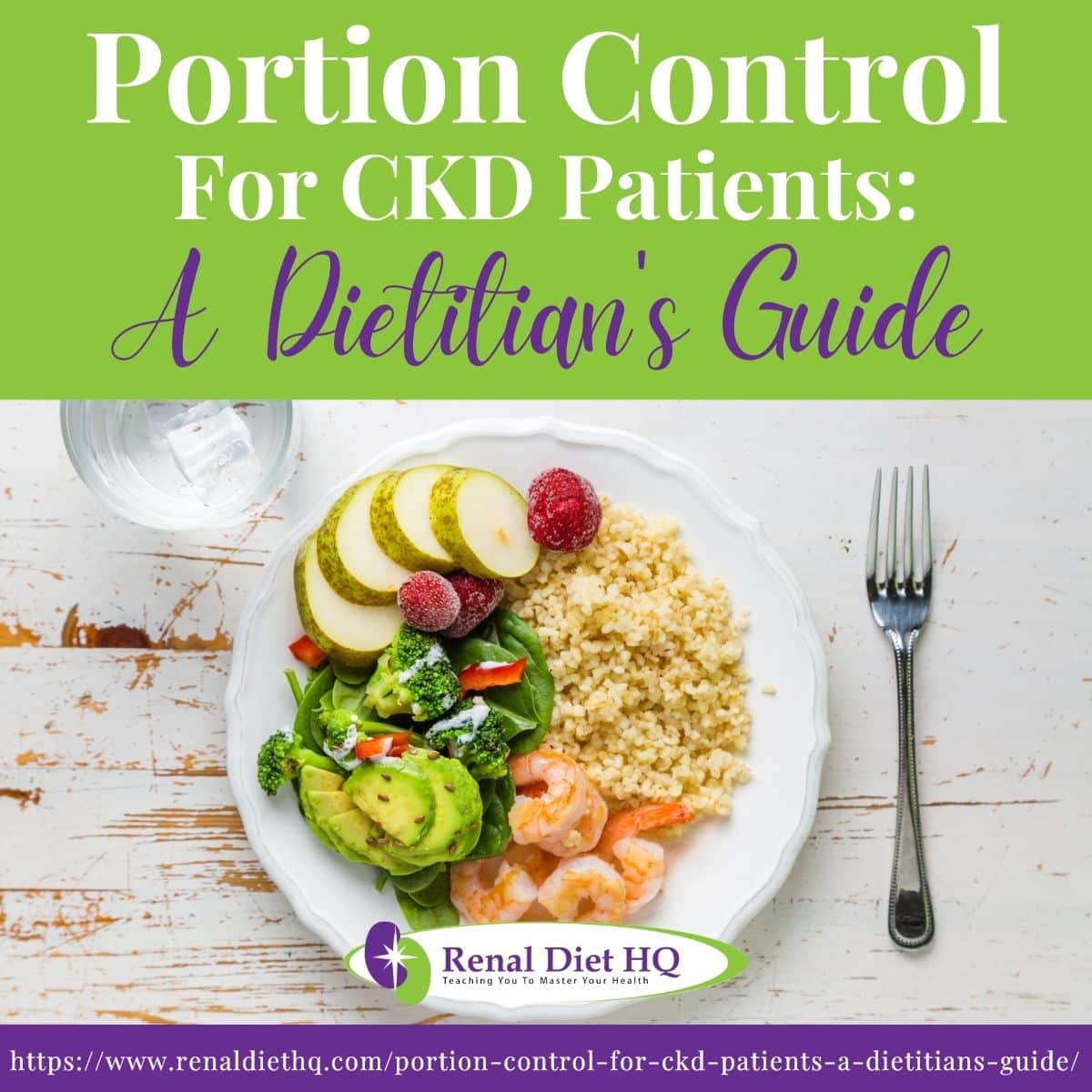
Role of Portion Control In Managing CKD
Portion control is an important tool for managing CKD. It helps to regulate the amount of food you eat and can help you stay on track with your dietary goals.
Overeating with CKD can put extra strain on the kidneys, so it's vital to understand portion control for CKD patients. By understanding what portion control is and how it works, you'll be better equipped to make healthier choices that are right for your body.
What Does Overeating with CKD Do?
Overeating with CKD can have serious consequences - it can lead to weight gain, high blood pressure, which can lead to kidney damage. It's important for CKD patients to be mindful of their food choices in order to avoid overeating.
Eating too much fat and salt consumption can lead to hypertension, while eating more calories than the recommended can lead to weight gain. Therefore, it's essential that CKD patients practice portion control in order to avoid any negative health effects associated with overeating.
Protein Portion Size
Protein is an essential macronutrient for CKD patients, and it's important to ensure that the right portions are consumed. Knowing what a protein portion size looks like can be tricky, but understanding your dietary needs and having snack tips will help you make good decisions about food swaps and meal timing.
Protein sources such as poultry, fish, egg whites, tofu, beans, nuts, seeds, and low fat dairy products should be incorporated into your kidney-friendly diet with moderation in order to meet your individual nutritional goals.
Eating the right amount of protein can help improve kidney function without overburdening your body - so it's wise to keep an eye on portion control when planning meals!
You may even find that looking at this cookbook for CKD patients helps you understand the diet a little better.
Carbohydrate Portion Sizes For Diabetic Kidney Patients
For diabetics, understanding the right carbohydrate portion size is key to managing blood sugar levels and overall health.
When selecting carbohydrates, it is important to choose nutrient-dense sources, such as whole grains, legumes, fresh fruits and vegetables.
To ensure that you are staying within your recommended portion sizes for diabetes management and diet management, it is important to read the ingredient labels carefully and be aware of standard serving sizes. Make sure to read labels carefully as a kidney patient.
The following table outlines some common carbohydrate sources with their corresponding serving sizes:
| Carbohydrate Source | Serving Size |
| Whole Grains (e.g., brown rice) | ½ cup cooked |
| Legumes (e.g., beans) | ½ cup |
| Fresh Fruits & Vegetables (e.g., apples) | 1 medium fruit or ½ cup of fresh, frozen, or canned fruits or vegetables |
By incorporating these guidelines into a daily meal plan, kidney patients with diabetes can better manage their blood sugar levels while still enjoying a variety of foods in proper portions.
Fat Portion Sizes
Managing your fat consumption is essential to maintaining a balanced diet and a healthy lifestyle. For those living with CKD, it's especially important to pay attention to the types of fats you're consuming and portion sizes.
Eating habits that include too much saturated or trans fat can increase health risks, so it's important to choose unsaturated fats such as olive oil, fish, and nuts instead. Start by planning out meals for the week ahead of time. This will help you stay on track with eating healthier portions of healthy fats throughout the day.
When selecting foods, make sure you read the nutrition label carefully in order to keep track of serving size and total fat content. Be mindful when cooking at home - use smaller pans or containers when prepping food so that portions remain under control.
To ensure that you're getting enough vitamins and minerals from your diet, talk to a registered dietitian about creating an individualized meal plan tailored specifically for CKD patients who need portion control.
Balance and Moderation with Portion Control
Balancing your food intake with moderation is the key to successful portion control. To ensure balance and moderation in your diet, eat a variety of foods from all the major food groups each day.
Choose nutrient-dense whole grains such as oats, quinoa, barley, and brown rice to include in meals or snacks.
Limit saturated fat intake by opting for lean proteins like fish, poultry, and beans instead of red meats when possible. For example, you may really enjoy this southwestern chicken and white bean soup.
Select fruits and vegetables in a variety of colors to incorporate vitamins, minerals, and antioxidants that promote good health.
Portion sizes are just as important as knowing which types of foods to choose because overeating can lead to weight gain or other adverse health effects over time.
Reading nutrition labels will help you determine how many servings are recommended for an individual meal or snack so that you can practice eating appropriate portions.
Additionally, creating healthy habits like regularly eating breakfast every morning helps maintain balance throughout the day so that cravings don't take over later on in the afternoon or evening. With careful planning and mindful portion control, you can enjoy delicious meals while staying within your nutritional needs!
Practical Tips for Portion Control
Practical tips for portion control:
Managing your portion sizes at home, controlling them when eating out, and using visual cues to estimate servings can all help you stick to a healthy diet for CKD.
Start by measuring and weighing foods at home so you'll know exactly how large a portion should be. When dining out, order single servings or ask the server to divide your meal in half before it's served.
Finally, use visual cues like your fist or palm to estimate appropriate portion sizes for food items that don't come with specific measurements. Check out these healthy recipes for kidney disease.
Managing Portion Sizes at Home
At home, you'll want to pay close attention to portion sizes in order to maintain good health and nutrition.
Serving sizes have a tendency to be larger than what's recommended for CKD patients, so it's important to practice self-control when eating.
One practical tip is to use smaller plate sizes at mealtimes - this will help ensure you don't overfill your plate. You can also try tracking your portions on paper or using an app - this will help you become more aware of how much food you're eating and how it affects your overall health.
Additionally, listening to your hunger cues is important as well. If you're not feeling hungry, don't force yourself to eat large meals just because there's food available.
Pair managing portion sizes with exercise for CKD patients and you'll have several tools in your hands to help you be successful.
Portion Control At Restaurants
It's important to learn how to portion control when dining out with kidney disease, especially for those with CKD. Fortunately, there are strategies and tips that can help you enjoy eating out while managing your health.
The first step is to identify healthy restaurant options. Look for restaurants that offer nutritious meals like grilled chicken or fish with vegetables instead of fried foods.
You can also ask the waiter about healthier alternatives that may not be listed on the menu. Additionally, ordering takeout is a great way to have more control over what you eat. You can also request modifications like omitting sauces or adding extra vegetables.
When it comes to eating out etiquette, it's important to practice mindful eating by avoiding distractions such as phones and televisions so you don't overeat without realizing it.
Additionally, try splitting your meal with someone else or opting for smaller portion sizes like tapas-style dishes instead of full entrees if possible. Here's a helpful table showing some portion control hacks for different types of restaurants:
By following these guidelines and strategies, CKD patients should be able to practice portion control successfully when dining out.
Visual Cues To Estimate Serving Sizes
You can use visual cues to help estimate serving sizes when eating out, making it easier to manage your health goals.
For CKD patients in particular, this is an important tool for staying on track with their kidney health. Knowing the size of a proper portion can be helpful in reducing appetite and avoiding over-eating.
As a dietitian's guide to serving sizes, you should be aware that a protein serving should generally be about the size of your palm.
One serving of carbohydrates tends to be about the size of a fist. For fats, a serving is equivalent to the size of the tip of the thumb, or one tablespoon.
When dining out, comparing the menu item you're considering to these sizes can give you an idea of how much food is being served. When grocery shopping, you can look at food labels and compare them to standard serving sizes listed on the label – this will help you determine what a healthy portion looks like for that specific item.
In addition, there are some simple tips for controlling portions: cut your meal in half; fill half of your plate with vegetables; eat slowly and wait 20 minutes before deciding if more food is needed; always leave something on your plate; find dishes with fewer calories per serving; have smaller snacks throughout the day instead of one large meal.
A good example is this renal diet meat portion control. By incorporating these strategies into your lifestyle, you'll be able to better manage portion control and keep your kidneys healthy.
How To Make Portion Control A Habit
Making portion control part of your daily routine can help to make the change easier. To start this, you can incorporate small changes into your existing lifestyle that will help you get used to using portion control. This is a good example of a renal diet plate.
For example, you could use smaller plates and utensils to reduce the amount of food you eat at one sitting.
Additionally, try using visual cues such as measuring cups or a kitchen scale to help you become more aware of how much food is actually on your plate.
Finally, be sure to track what and how much you're eating with an online nutrition tracker or journal; this will help remind you and keep you accountable for portion sizes.
Tips On Using Portion Control Daily
Using portion control can be a great way to help manage CKD (how to manage chronic kidney disease), and here are some tips to get you started. Measuring servings is a great place to start when trying to use portion control.
Using measuring cups or spoons is the best way to determine how much of each food group you should eat at each meal.
Tracking your food intake is important for staying accountable and ensuring that your portions are appropriate for your health goals. There are many apps available today that make it easy to track what you eat and compare it against recommended serving sizes.
Making healthy swaps when possible can also help with portion control. Instead of white bread, choose whole-wheat options instead; instead of potato chips, opt for air-popped unsalted popcorn; and replace sodas with tea or water.
Being mindful when shopping will ensure that unhealthy items do not find their way into your home in the first place! Finally, mindful eating is key when using portion control techniques — take time to savor each bite and enjoy the flavors while still maintaining healthy portions!
| Foods to avoid | Foods to choose instead |
| White bread | Whole-wheat bread |
| Potato chips | Air-popped popcorn |
| Sodas | Tea/water |
| Cow milk | Almond milk, oat milk, soy milk |
Frequently Asked Questions
When following a CKD diet, it's important to avoid processed foods as much as possible. Lowering sodium intake and eating fiber-rich foods such as fruits, vegetables, and whole grains are also recommended.
Protein should be consumed in moderation as a part of a healthy diet. Additionally, it's best to avoid added sugars whenever possible.
By taking these steps, you can ensure that your diet is balanced and beneficial in managing your kidney disease.
If you are struggling with finding foods you can enjoy, here are low sodium canned foods for CKD.
Tracking your food intake and reading nutrition labels are important aspects of ensuring that you're getting enough vitamins and minerals on a CKD diet.
Supplementing with additional vitamins can be beneficial, but make sure to consult with your healthcare provider first.
Keeping track of what you eat is key to making sure that you're getting all the essential nutrients your body needs without going overboard.
You should talk with a dietitian who specializes in CKD nutrition to ensure you're eating right for your individual needs.
It's important to drink plenty of fluids during early stage kidney disease. In general, aim for 8 glasses of water per day in CKD stages 1-2.
However, once you reach stages 3-5, you may have to limit your fluid intake as your kidneys may have trouble getting rid of excess fluids.
Be sure to talk with your doctor or registered dietitian (RD) about how much is right for you. There are also water rich foods that you can enjoy or take precaution in when consuming.
Eating out on a CKD diet doesn't have to be difficult. With the right preparations, you can enjoy meals that fit your dietary needs and still feel satisfied.
Start by researching restaurant choices in advance, seeking out those with lighter menu items or food substitutions such as vegetable-based options or grilled proteins.
When you arrive at the restaurant, request smaller portions sizes or side dishes instead of full entrées. If that isn't possible, split an entrée with someone else.
Ask questions about preparation methods and the ingredient list so you know exactly what's going into your meal - it's best to avoid foods high in sodium and deep-fried dishes when eating out safely on a CKD diet.
If you get the chance, read this book on eating out with kidney disease.
When it comes to portion control, there are alternative methods you can use beyond measuring and weighing food.
For instance, visualizing servings is a helpful technique that involves using your hand or everyday objects to measure out portions.
You can also look at food labeling and nutrition facts for guidance on how much you should be eating in one sitting. Eating slowly will also help as it takes time for the brain to register when you're full. Overtime, you'll become an expert at reading nutrition facts labels with CKD.
Additionally, making smart snack choices and tracking what you eat throughout the day can help keep your portions in check.
Portion Control Is Essential For Chronic Kidney Disease
Managing chronic kidney disease (CKD) through diet and portion control doesn't have to be a challenge. With the help of your dietitian, you can create an eating plan that meets your dietary needs while still allowing you to enjoy food.
Portion control is an important factor in managing CKD. Therefore, it's important to become familiar with proper portion sizes and how to make them a habit. Eating a renal diet breakfast, lunch dinner can happen with these tips!
With the right approach and support from your healthcare team, you can successfully manage your CKD through nutrition and lifestyle changes.

